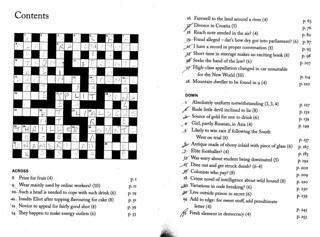You could argue that crossword solving is a very good example of computational thinking. That is certainly what the security services thought during WW2 when they asked The Times to send them the names of anyone who could solve a cryptic crossword they’d supplied in 12 minutes or less. Those that did were invited to work at Bletchley Park, cracking codes for the war effort.
The year 2013 saw the centenary of the crossword. For a hundred years people have been whiling away their time pitting their wits against those of the compiler. In the UK, the cryptic crossword has evolved into a genre – well, several genres, in fact – of its own. The cryptic crossword is less common in other parts of the world, where the plain version is often preferred. The aim of the crossword setter has been defined, rather nicely I think, as to lose gracefully.
But cryptic? Plain? What does it all mean? In a nutshell, the plain crossword asks you to look for synonyms, whereas the cryptic one provides you with an indication of what the answer might be. That’s why, paradoxically, cryptic crosswords are easier to do than the plain ones. But only easier once you have got the point, or, to put it another way, cracked the code.
All of this is explained more than adequately in Alan Connor’s book, “Two girls, one on each knee (7)”. But before looking at this, what have crosswords got to do with computing and ICT anyway?
The obvious answer is that solving a cryptic crossword requires a mix of logical and lateral thinking – a bit like computer programming, in fact. Which is why, of course, the Bletchley Park people recognised the ability to solve cryptic crosswords as being a key skill in their line of work. It’s not just logical thinking that’s involved, but the ability to make almost intuitive leaps in the dark.
Let’s take a clue like this:
Egyptian flower (4)
You could spend a long time trying to think of the name of a flower that grows in Egypt. But if you use a bit of lateral thinking, and pronounce “flower” as “flow-er”, ie something that flows, you will immediately realise that you’re meant to come up with the name of an Eqyptian river. The answer is obvious: Nile.
Or take the title of the book itself:
Two girls, one on each knee (7)
The image it conjures up seems to have very little to do with the recreational pursuit of solving a crossword. So, you need a bit of lateral thinking and logic to work your way through this one. What you’re trying to find out is the name of something people have on their knees. Tow two “girls” referred to are Pat and Ella, giving you “patella”.

This and other delightful snippets of information, along with copious advice about how to solve fiendish crossword clues, are to be found in this delightful book. Like its subject matter, the book is playful: the table of contents is itself in the form of a crossword, and even when you have solved the clues you are none the wiser as to the subject matter they refer to! Like some of the more extreme crosswords, solving the clues leads merely to further conundrums.
The joke is carried on throughout the book: when cross-referencing other chapters, the author says, for example, “See One Down”.
If you like doing crosswords, and love language, and wish to find out more about the history of crosswords and the various forms it takes, you will enjoy this book.
Alan Connor, Two Girls, One On Each Knee (7): The puzzling, playful world of the crossword, Particular Books (an imprint of Penguin Books), 2013. ISBN: 978-1-846-14841-5
This article first appeared in Digital Education, our free newsletter. Please see below for the subscription link.

Your newsletter editor is hard at work sifting through the submissions for Digital Education, the free newsletter for education professionals. Have you subscribed yet?
Read more about it, and subscribe, on the Newsletter page of the ICT in Education website. We use a double opt-in system, and you won’t get spammed.
 This and other delightful snippets of information, along with copious advice about how to solve fiendish crossword clues, are to be found in this delightful book. Like its subject matter, the book is playful: the table of contents is itself in the form of a crossword, and even when you have solved the clues you are none the wiser as to the subject matter they refer to! Like some of the more extreme crosswords, solving the clues leads merely to further conundrums.
This and other delightful snippets of information, along with copious advice about how to solve fiendish crossword clues, are to be found in this delightful book. Like its subject matter, the book is playful: the table of contents is itself in the form of a crossword, and even when you have solved the clues you are none the wiser as to the subject matter they refer to! Like some of the more extreme crosswords, solving the clues leads merely to further conundrums.
